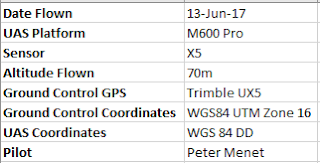Processing Data in Pix4D with Ground Control Points

Introduction In this lab ground control points are utilized to help make our final outputs more accurate, and reduce some of the distortions that can exist without GCPs. GCPs are specific locations in the surveyed area that have a known coordinate allowing for more accurate location calibration within the software. The fact that the GCPs have known coordinates will increase the quality of our output tremendously by being able to more accurately organize the surrounding images based on their proximity to the ground control point. Checkpoints can also be used to help increase the quality of a product. While ground control points are used as a georeference for the product, checkpoints simply check accuracy of the model by showing the percent error of the images. Methods The metadata for this specific flight is shown in figure 1 below. Figure 1: Flight metadata As with some of the previous labs, based on the specific sensor used for the flight, the shutter type m...

